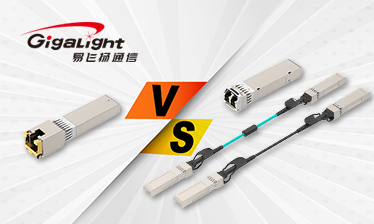Is A Copper Transceiver Or An Optical Transceiver, DAC, AOC Better?
The copper transceiver is a communication interface that through copper cables (such as twisted pair network cables). It is also a type of optical transceiver.
With the rapid development of communication technology, various transceivers have sprung up, among which copper transceivers, optical transceivers, DAC (Direct Attach Cable) and AOC (Active Optical Cable) have become hot choices in the industry. These transceivers have their own strengths and play important roles in different scenarios. To better meet communication needs, we need to deeply understand their characteristics and advantages in order to make wise choices in practical applications. Next, this article will focus on the comparison between copper transceivers, optical transceivers, DAC, and AOC, aiming to help readers better understand and choose suitable communication transceivers for themselves.

Copper Transceiver VS DAC
Both the copper transceiver and the DAC are suitable for short-distance transmission applications, and both are transmitted through copper cables. However, the transmission distance of the copper transceiver is larger than that of the DAC. The transmission distance of the DAC generally does not exceed 7m, while the copper transceiver can transmit 30m.
Copper Transceiver VS AOC
The copper transceiver uses copper cable for transmission, while the AOC uses optical cable. Therefore, the copper transceiver has a longer transmission distance, up to 300m. AOC has enhanced signal integrity and flexible deployment methods, and has better air flow and heat dissipation in the computer room cabling system, but its cost is higher than copper cabling at the 10G rate.
Copper Transceiver VS Optical transceiver
Compared with optical transceivers, copper transceivers use copper cables for wiring, while optical transceivers require optical fibers for wiring. If the original wiring system uses copper cables, using copper transceivers can reuse the previous copper cable wiring resources to complete the 10G network deploy. In terms of transmission distance, the transmission distance of the copper transceivers is relatively short, and the transmission distance of the optical transceiver can be as high as 120km according to different combinations.
GIGALIGHT Copper Transceiver
100M Copper SFP, including 100M single rate and 10/100M adaptive rate, adopts RJ45 interface, and can transmit up to 100m with Cat5/5e network cable. There are two options: commercial grade and industrial grade.
1G Copper SFP, including 1G and 10/100/1000m adaptive rate, also uses RJ45 interface, can transmit 100m with Cat5/5e network cable, and the temperature range is commercial grade.
10G Copper SFP supports 10G rate transmission, uses RJ45 interface, and can transmit up to 30m with Cat6/6A network cable, and the temperature range is commercial grade.
From the latest perspective, copper transceivers are still widely used in Ethernet, especially for connections within data centers and local area networks. They are known for their reliability and cost-effectiveness, making them a popular choice for many organizations. However, as the demand for higher data rates and bandwidth continues to increase, some applications have turned to optical transceivers because of their ability to support higher data rates and longer transmission distances.
Overall, copper transceivers continue to play a vital role in network infrastructure, providing a stable and efficient way to transmit data over copper cables. Their versatility and compatibility with existing network setups make them an essential component in modern communication systems.
